B11269 Entrepreneurship & Small Business Management Report
VerifiedAdded on 2023/01/12
|16
|4615
|79
Report
AI Summary
This report is divided into two parts, addressing the impact of various ventures on the economy and analyzing entrepreneurial characteristics. Part 1 examines the effects of local, social, and global ventures, highlighting their contributions to job creation, economic growth, and international competitiveness. It contrasts entrepreneurial ventures, differentiating between small and medium-sized businesses and large enterprises, and discusses their similarities and differences in terms of governance, decision-making, market focus, and job security. Part 2 delves into the traits of successful entrepreneurs, exploring how background and experience influence entrepreneurial endeavors. It analyzes characteristics, skills, and motivational drivers, using case studies to illustrate these concepts. The report emphasizes the importance of innovation, risk-taking, and customer satisfaction in entrepreneurial success, providing a comprehensive overview of the entrepreneurial landscape and its impact on economic development.

B11269
Entrepreneurship &
Small Business
Management
Entrepreneurship &
Small Business
Management
Secure Best Marks with AI Grader
Need help grading? Try our AI Grader for instant feedback on your assignments.
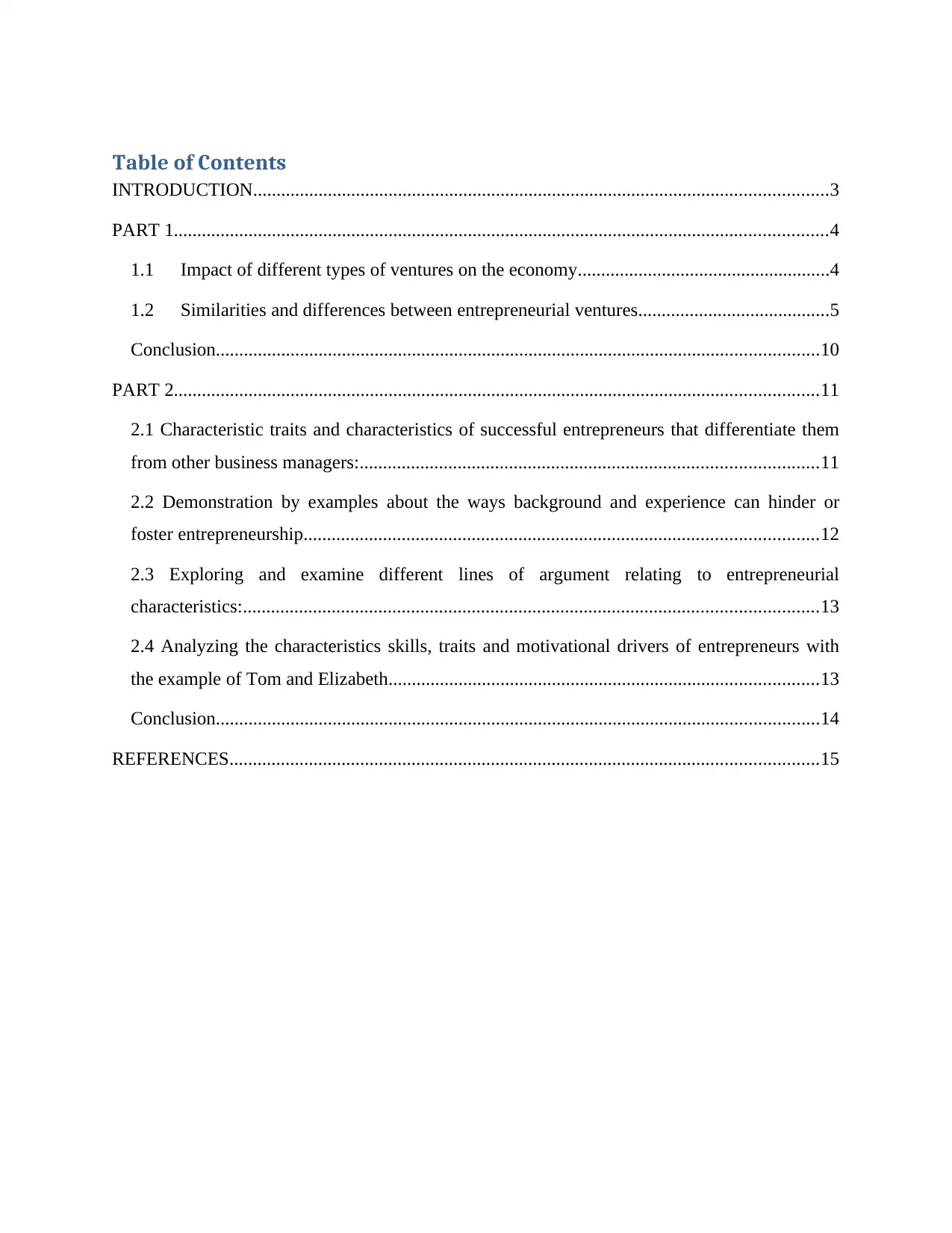
Table of Contents
INTRODUCTION...........................................................................................................................3
PART 1............................................................................................................................................4
1.1 Impact of different types of ventures on the economy......................................................4
1.2 Similarities and differences between entrepreneurial ventures.........................................5
Conclusion.................................................................................................................................10
PART 2..........................................................................................................................................11
2.1 Characteristic traits and characteristics of successful entrepreneurs that differentiate them
from other business managers:..................................................................................................11
2.2 Demonstration by examples about the ways background and experience can hinder or
foster entrepreneurship..............................................................................................................12
2.3 Exploring and examine different lines of argument relating to entrepreneurial
characteristics:...........................................................................................................................13
2.4 Analyzing the characteristics skills, traits and motivational drivers of entrepreneurs with
the example of Tom and Elizabeth............................................................................................13
Conclusion.................................................................................................................................14
REFERENCES..............................................................................................................................15
INTRODUCTION...........................................................................................................................3
PART 1............................................................................................................................................4
1.1 Impact of different types of ventures on the economy......................................................4
1.2 Similarities and differences between entrepreneurial ventures.........................................5
Conclusion.................................................................................................................................10
PART 2..........................................................................................................................................11
2.1 Characteristic traits and characteristics of successful entrepreneurs that differentiate them
from other business managers:..................................................................................................11
2.2 Demonstration by examples about the ways background and experience can hinder or
foster entrepreneurship..............................................................................................................12
2.3 Exploring and examine different lines of argument relating to entrepreneurial
characteristics:...........................................................................................................................13
2.4 Analyzing the characteristics skills, traits and motivational drivers of entrepreneurs with
the example of Tom and Elizabeth............................................................................................13
Conclusion.................................................................................................................................14
REFERENCES..............................................................................................................................15
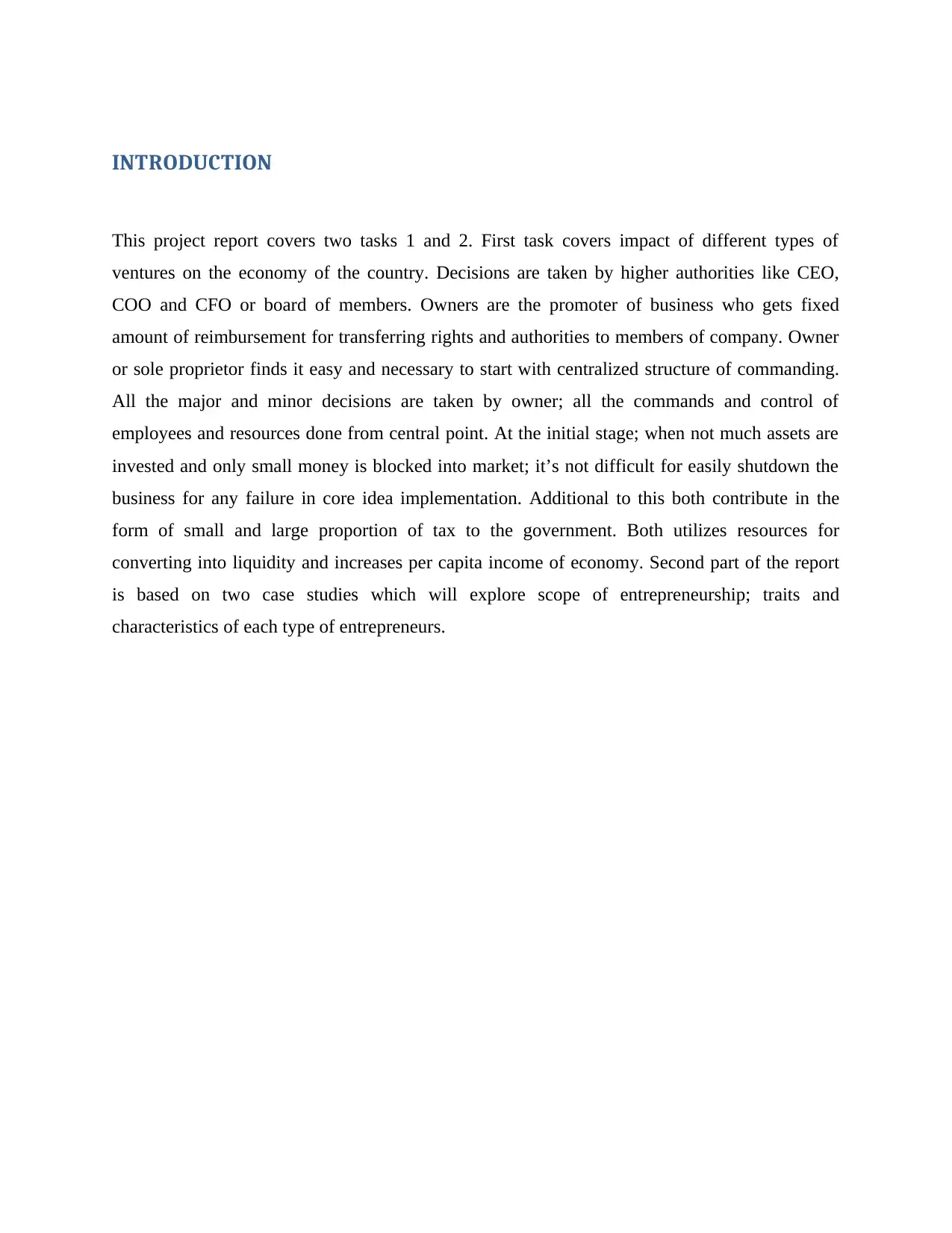
INTRODUCTION
This project report covers two tasks 1 and 2. First task covers impact of different types of
ventures on the economy of the country. Decisions are taken by higher authorities like CEO,
COO and CFO or board of members. Owners are the promoter of business who gets fixed
amount of reimbursement for transferring rights and authorities to members of company. Owner
or sole proprietor finds it easy and necessary to start with centralized structure of commanding.
All the major and minor decisions are taken by owner; all the commands and control of
employees and resources done from central point. At the initial stage; when not much assets are
invested and only small money is blocked into market; it’s not difficult for easily shutdown the
business for any failure in core idea implementation. Additional to this both contribute in the
form of small and large proportion of tax to the government. Both utilizes resources for
converting into liquidity and increases per capita income of economy. Second part of the report
is based on two case studies which will explore scope of entrepreneurship; traits and
characteristics of each type of entrepreneurs.
This project report covers two tasks 1 and 2. First task covers impact of different types of
ventures on the economy of the country. Decisions are taken by higher authorities like CEO,
COO and CFO or board of members. Owners are the promoter of business who gets fixed
amount of reimbursement for transferring rights and authorities to members of company. Owner
or sole proprietor finds it easy and necessary to start with centralized structure of commanding.
All the major and minor decisions are taken by owner; all the commands and control of
employees and resources done from central point. At the initial stage; when not much assets are
invested and only small money is blocked into market; it’s not difficult for easily shutdown the
business for any failure in core idea implementation. Additional to this both contribute in the
form of small and large proportion of tax to the government. Both utilizes resources for
converting into liquidity and increases per capita income of economy. Second part of the report
is based on two case studies which will explore scope of entrepreneurship; traits and
characteristics of each type of entrepreneurs.
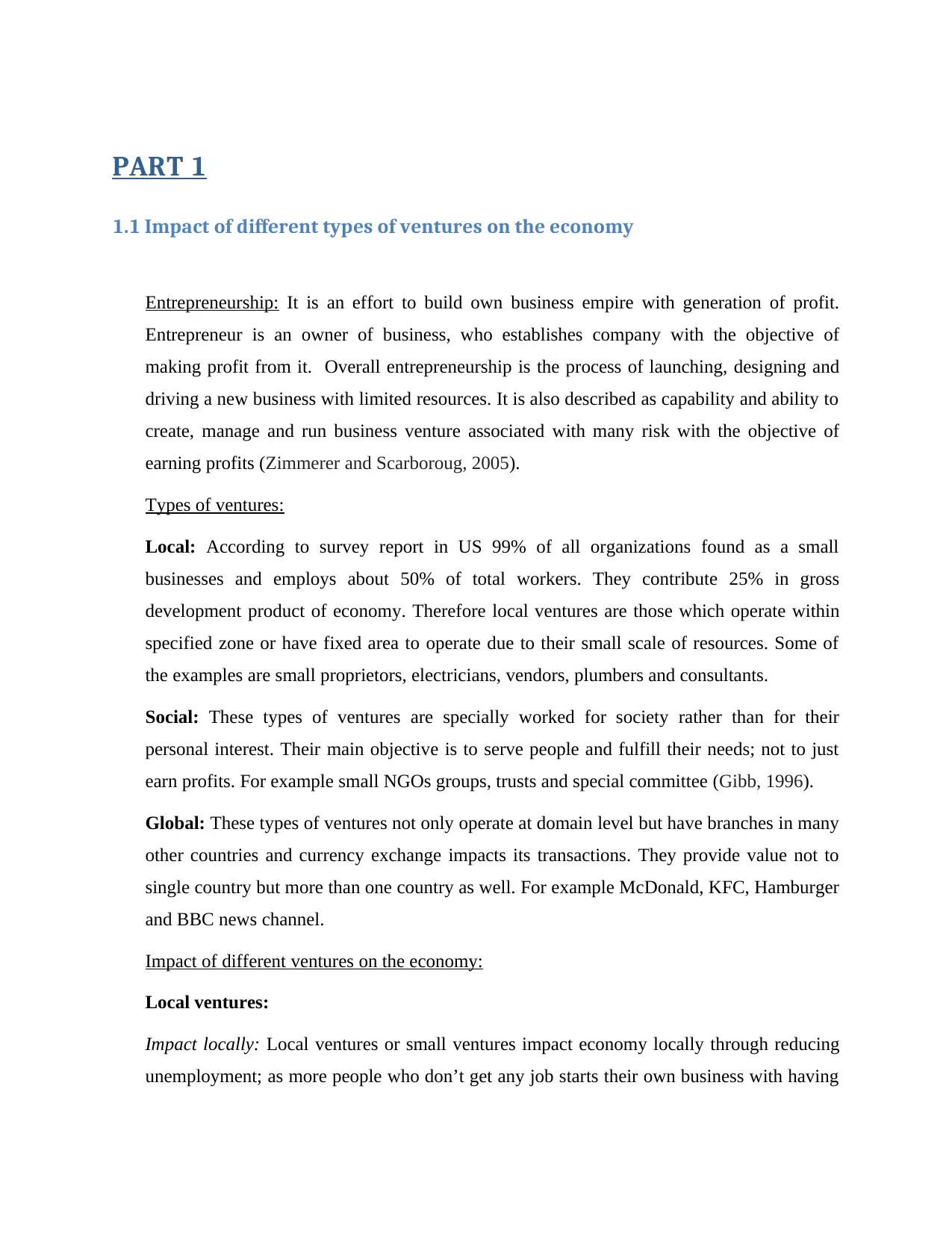
PART 1
1.1 Impact of different types of ventures on the economy
Entrepreneurship: It is an effort to build own business empire with generation of profit.
Entrepreneur is an owner of business, who establishes company with the objective of
making profit from it. Overall entrepreneurship is the process of launching, designing and
driving a new business with limited resources. It is also described as capability and ability to
create, manage and run business venture associated with many risk with the objective of
earning profits (Zimmerer and Scarboroug, 2005).
Types of ventures:
Local: According to survey report in US 99% of all organizations found as a small
businesses and employs about 50% of total workers. They contribute 25% in gross
development product of economy. Therefore local ventures are those which operate within
specified zone or have fixed area to operate due to their small scale of resources. Some of
the examples are small proprietors, electricians, vendors, plumbers and consultants.
Social: These types of ventures are specially worked for society rather than for their
personal interest. Their main objective is to serve people and fulfill their needs; not to just
earn profits. For example small NGOs groups, trusts and special committee (Gibb, 1996).
Global: These types of ventures not only operate at domain level but have branches in many
other countries and currency exchange impacts its transactions. They provide value not to
single country but more than one country as well. For example McDonald, KFC, Hamburger
and BBC news channel.
Impact of different ventures on the economy:
Local ventures:
Impact locally: Local ventures or small ventures impact economy locally through reducing
unemployment; as more people who don’t get any job starts their own business with having
1.1 Impact of different types of ventures on the economy
Entrepreneurship: It is an effort to build own business empire with generation of profit.
Entrepreneur is an owner of business, who establishes company with the objective of
making profit from it. Overall entrepreneurship is the process of launching, designing and
driving a new business with limited resources. It is also described as capability and ability to
create, manage and run business venture associated with many risk with the objective of
earning profits (Zimmerer and Scarboroug, 2005).
Types of ventures:
Local: According to survey report in US 99% of all organizations found as a small
businesses and employs about 50% of total workers. They contribute 25% in gross
development product of economy. Therefore local ventures are those which operate within
specified zone or have fixed area to operate due to their small scale of resources. Some of
the examples are small proprietors, electricians, vendors, plumbers and consultants.
Social: These types of ventures are specially worked for society rather than for their
personal interest. Their main objective is to serve people and fulfill their needs; not to just
earn profits. For example small NGOs groups, trusts and special committee (Gibb, 1996).
Global: These types of ventures not only operate at domain level but have branches in many
other countries and currency exchange impacts its transactions. They provide value not to
single country but more than one country as well. For example McDonald, KFC, Hamburger
and BBC news channel.
Impact of different ventures on the economy:
Local ventures:
Impact locally: Local ventures or small ventures impact economy locally through reducing
unemployment; as more people who don’t get any job starts their own business with having
Secure Best Marks with AI Grader
Need help grading? Try our AI Grader for instant feedback on your assignments.
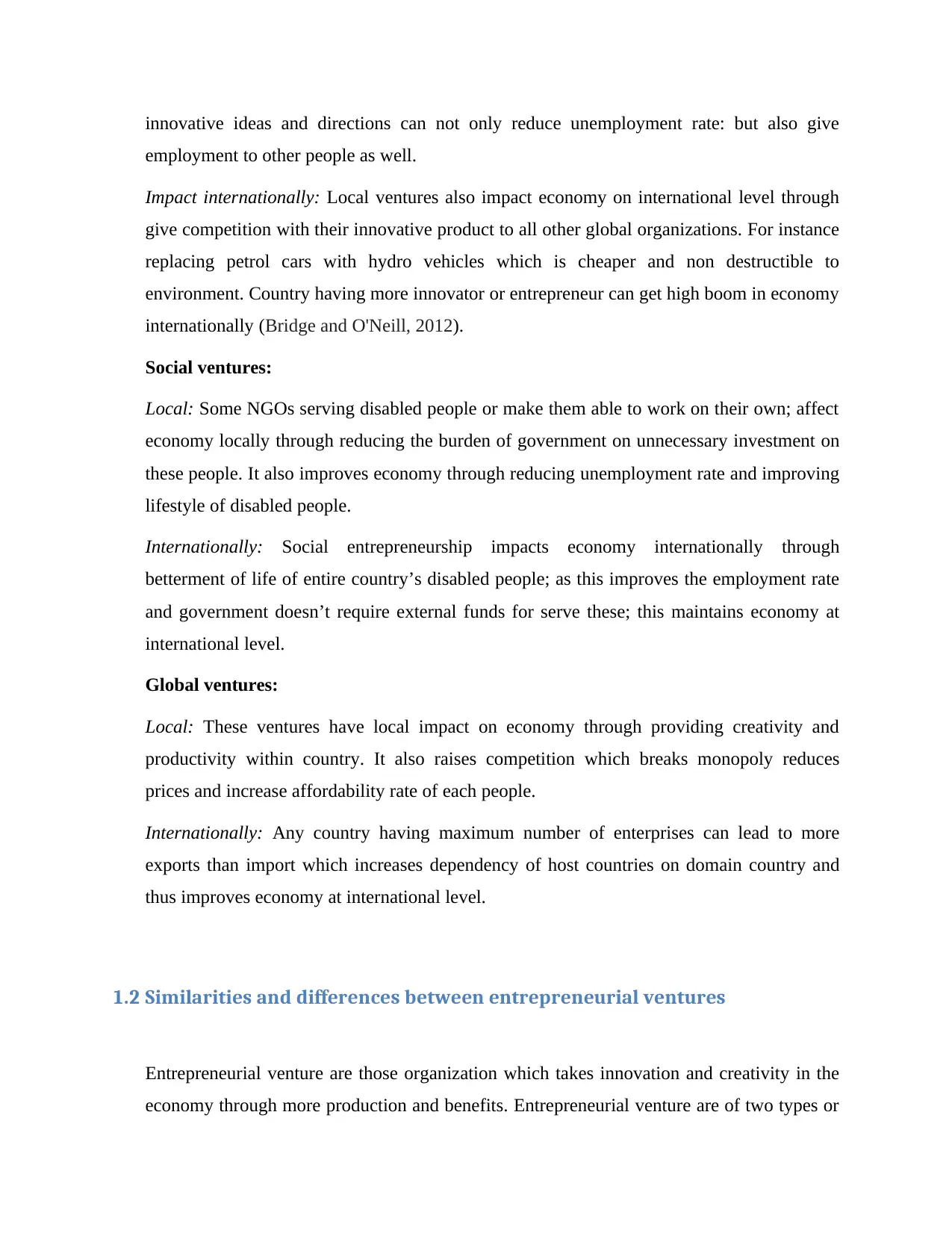
innovative ideas and directions can not only reduce unemployment rate: but also give
employment to other people as well.
Impact internationally: Local ventures also impact economy on international level through
give competition with their innovative product to all other global organizations. For instance
replacing petrol cars with hydro vehicles which is cheaper and non destructible to
environment. Country having more innovator or entrepreneur can get high boom in economy
internationally (Bridge and O'Neill, 2012).
Social ventures:
Local: Some NGOs serving disabled people or make them able to work on their own; affect
economy locally through reducing the burden of government on unnecessary investment on
these people. It also improves economy through reducing unemployment rate and improving
lifestyle of disabled people.
Internationally: Social entrepreneurship impacts economy internationally through
betterment of life of entire country’s disabled people; as this improves the employment rate
and government doesn’t require external funds for serve these; this maintains economy at
international level.
Global ventures:
Local: These ventures have local impact on economy through providing creativity and
productivity within country. It also raises competition which breaks monopoly reduces
prices and increase affordability rate of each people.
Internationally: Any country having maximum number of enterprises can lead to more
exports than import which increases dependency of host countries on domain country and
thus improves economy at international level.
1.2 Similarities and differences between entrepreneurial ventures
Entrepreneurial venture are those organization which takes innovation and creativity in the
economy through more production and benefits. Entrepreneurial venture are of two types or
employment to other people as well.
Impact internationally: Local ventures also impact economy on international level through
give competition with their innovative product to all other global organizations. For instance
replacing petrol cars with hydro vehicles which is cheaper and non destructible to
environment. Country having more innovator or entrepreneur can get high boom in economy
internationally (Bridge and O'Neill, 2012).
Social ventures:
Local: Some NGOs serving disabled people or make them able to work on their own; affect
economy locally through reducing the burden of government on unnecessary investment on
these people. It also improves economy through reducing unemployment rate and improving
lifestyle of disabled people.
Internationally: Social entrepreneurship impacts economy internationally through
betterment of life of entire country’s disabled people; as this improves the employment rate
and government doesn’t require external funds for serve these; this maintains economy at
international level.
Global ventures:
Local: These ventures have local impact on economy through providing creativity and
productivity within country. It also raises competition which breaks monopoly reduces
prices and increase affordability rate of each people.
Internationally: Any country having maximum number of enterprises can lead to more
exports than import which increases dependency of host countries on domain country and
thus improves economy at international level.
1.2 Similarities and differences between entrepreneurial ventures
Entrepreneurial venture are those organization which takes innovation and creativity in the
economy through more production and benefits. Entrepreneurial venture are of two types or
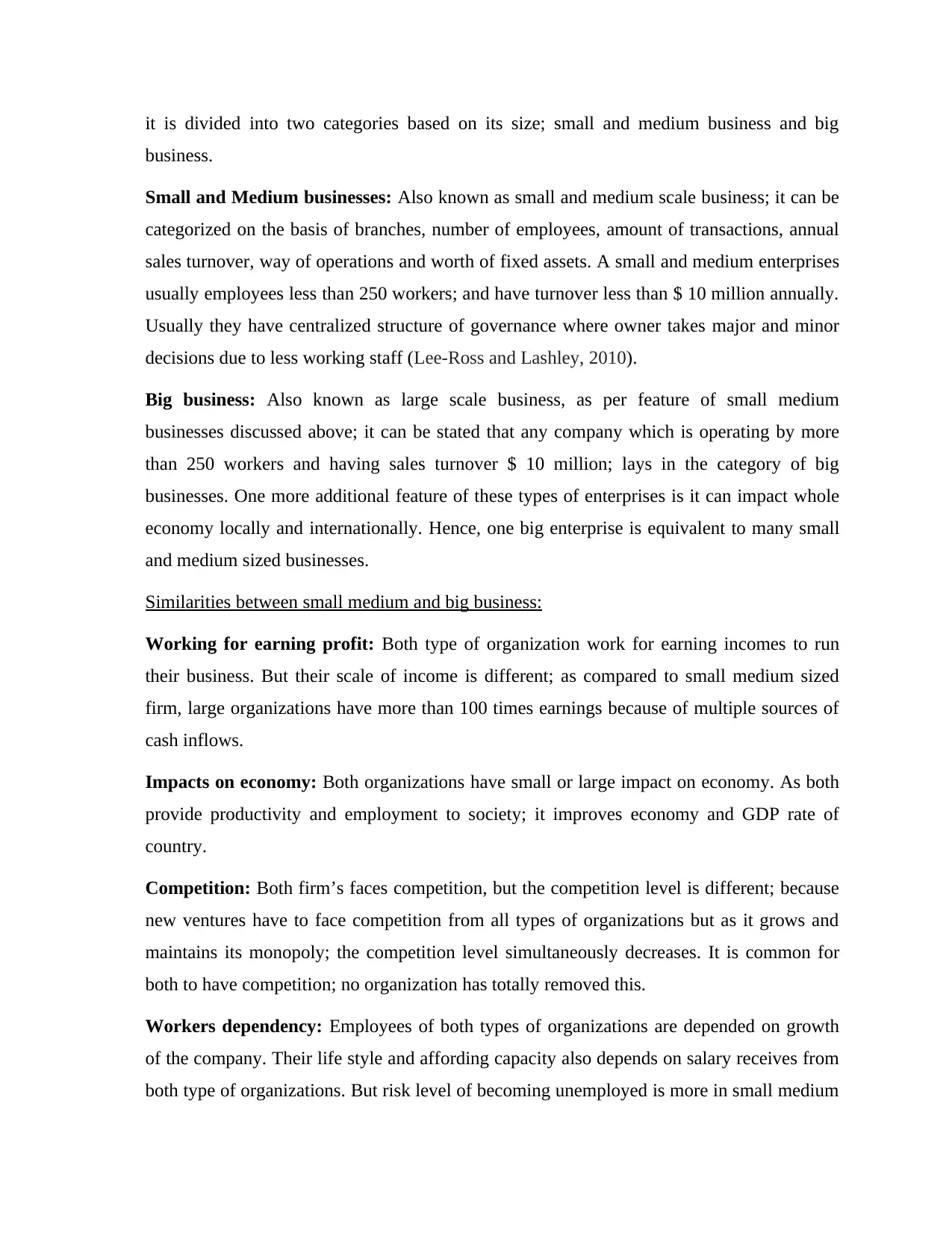
it is divided into two categories based on its size; small and medium business and big
business.
Small and Medium businesses: Also known as small and medium scale business; it can be
categorized on the basis of branches, number of employees, amount of transactions, annual
sales turnover, way of operations and worth of fixed assets. A small and medium enterprises
usually employees less than 250 workers; and have turnover less than $ 10 million annually.
Usually they have centralized structure of governance where owner takes major and minor
decisions due to less working staff (Lee-Ross and Lashley, 2010).
Big business: Also known as large scale business, as per feature of small medium
businesses discussed above; it can be stated that any company which is operating by more
than 250 workers and having sales turnover $ 10 million; lays in the category of big
businesses. One more additional feature of these types of enterprises is it can impact whole
economy locally and internationally. Hence, one big enterprise is equivalent to many small
and medium sized businesses.
Similarities between small medium and big business:
Working for earning profit: Both type of organization work for earning incomes to run
their business. But their scale of income is different; as compared to small medium sized
firm, large organizations have more than 100 times earnings because of multiple sources of
cash inflows.
Impacts on economy: Both organizations have small or large impact on economy. As both
provide productivity and employment to society; it improves economy and GDP rate of
country.
Competition: Both firm’s faces competition, but the competition level is different; because
new ventures have to face competition from all types of organizations but as it grows and
maintains its monopoly; the competition level simultaneously decreases. It is common for
both to have competition; no organization has totally removed this.
Workers dependency: Employees of both types of organizations are depended on growth
of the company. Their life style and affording capacity also depends on salary receives from
both type of organizations. But risk level of becoming unemployed is more in small medium
business.
Small and Medium businesses: Also known as small and medium scale business; it can be
categorized on the basis of branches, number of employees, amount of transactions, annual
sales turnover, way of operations and worth of fixed assets. A small and medium enterprises
usually employees less than 250 workers; and have turnover less than $ 10 million annually.
Usually they have centralized structure of governance where owner takes major and minor
decisions due to less working staff (Lee-Ross and Lashley, 2010).
Big business: Also known as large scale business, as per feature of small medium
businesses discussed above; it can be stated that any company which is operating by more
than 250 workers and having sales turnover $ 10 million; lays in the category of big
businesses. One more additional feature of these types of enterprises is it can impact whole
economy locally and internationally. Hence, one big enterprise is equivalent to many small
and medium sized businesses.
Similarities between small medium and big business:
Working for earning profit: Both type of organization work for earning incomes to run
their business. But their scale of income is different; as compared to small medium sized
firm, large organizations have more than 100 times earnings because of multiple sources of
cash inflows.
Impacts on economy: Both organizations have small or large impact on economy. As both
provide productivity and employment to society; it improves economy and GDP rate of
country.
Competition: Both firm’s faces competition, but the competition level is different; because
new ventures have to face competition from all types of organizations but as it grows and
maintains its monopoly; the competition level simultaneously decreases. It is common for
both to have competition; no organization has totally removed this.
Workers dependency: Employees of both types of organizations are depended on growth
of the company. Their life style and affording capacity also depends on salary receives from
both type of organizations. But risk level of becoming unemployed is more in small medium
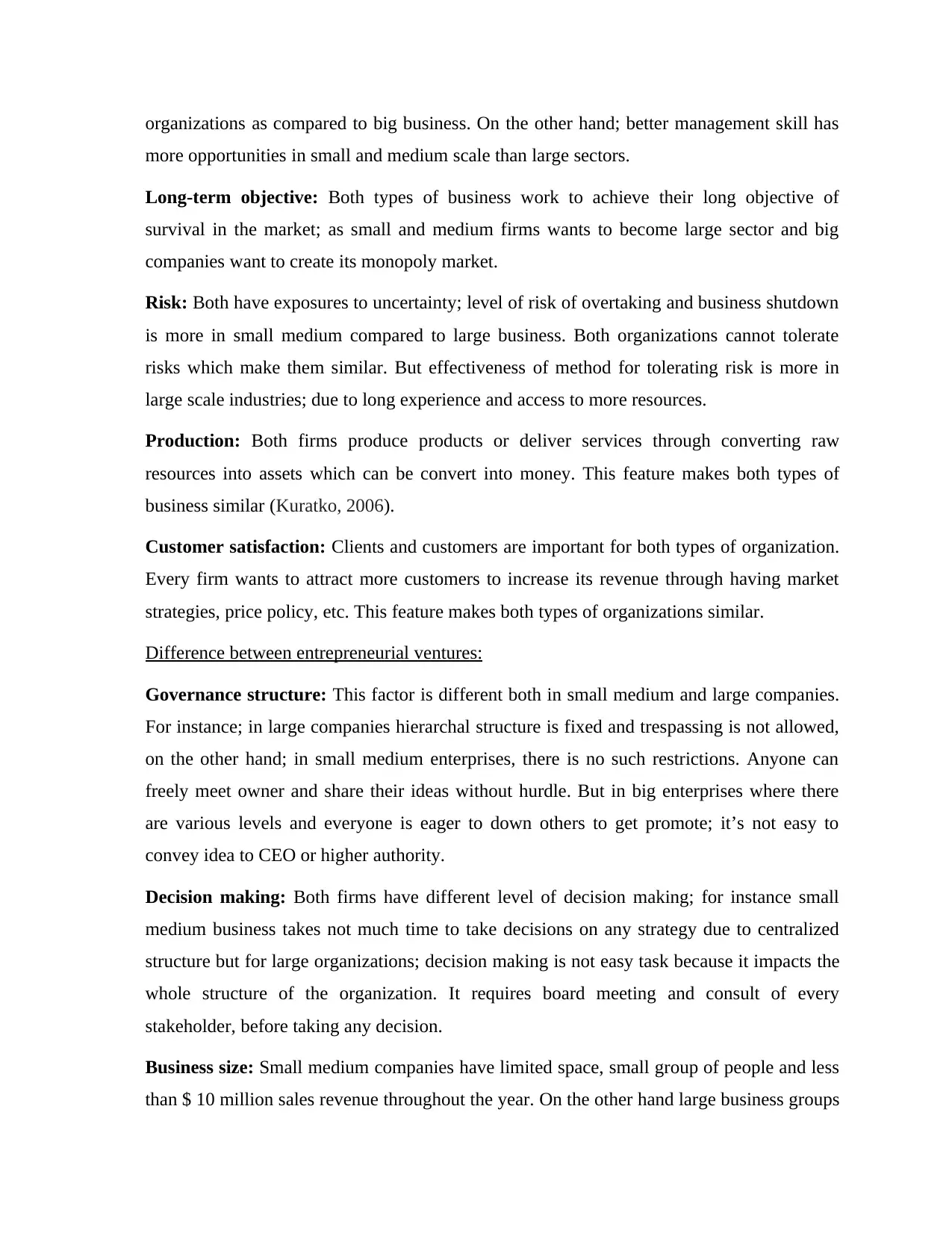
organizations as compared to big business. On the other hand; better management skill has
more opportunities in small and medium scale than large sectors.
Long-term objective: Both types of business work to achieve their long objective of
survival in the market; as small and medium firms wants to become large sector and big
companies want to create its monopoly market.
Risk: Both have exposures to uncertainty; level of risk of overtaking and business shutdown
is more in small medium compared to large business. Both organizations cannot tolerate
risks which make them similar. But effectiveness of method for tolerating risk is more in
large scale industries; due to long experience and access to more resources.
Production: Both firms produce products or deliver services through converting raw
resources into assets which can be convert into money. This feature makes both types of
business similar (Kuratko, 2006).
Customer satisfaction: Clients and customers are important for both types of organization.
Every firm wants to attract more customers to increase its revenue through having market
strategies, price policy, etc. This feature makes both types of organizations similar.
Difference between entrepreneurial ventures:
Governance structure: This factor is different both in small medium and large companies.
For instance; in large companies hierarchal structure is fixed and trespassing is not allowed,
on the other hand; in small medium enterprises, there is no such restrictions. Anyone can
freely meet owner and share their ideas without hurdle. But in big enterprises where there
are various levels and everyone is eager to down others to get promote; it’s not easy to
convey idea to CEO or higher authority.
Decision making: Both firms have different level of decision making; for instance small
medium business takes not much time to take decisions on any strategy due to centralized
structure but for large organizations; decision making is not easy task because it impacts the
whole structure of the organization. It requires board meeting and consult of every
stakeholder, before taking any decision.
Business size: Small medium companies have limited space, small group of people and less
than $ 10 million sales revenue throughout the year. On the other hand large business groups
more opportunities in small and medium scale than large sectors.
Long-term objective: Both types of business work to achieve their long objective of
survival in the market; as small and medium firms wants to become large sector and big
companies want to create its monopoly market.
Risk: Both have exposures to uncertainty; level of risk of overtaking and business shutdown
is more in small medium compared to large business. Both organizations cannot tolerate
risks which make them similar. But effectiveness of method for tolerating risk is more in
large scale industries; due to long experience and access to more resources.
Production: Both firms produce products or deliver services through converting raw
resources into assets which can be convert into money. This feature makes both types of
business similar (Kuratko, 2006).
Customer satisfaction: Clients and customers are important for both types of organization.
Every firm wants to attract more customers to increase its revenue through having market
strategies, price policy, etc. This feature makes both types of organizations similar.
Difference between entrepreneurial ventures:
Governance structure: This factor is different both in small medium and large companies.
For instance; in large companies hierarchal structure is fixed and trespassing is not allowed,
on the other hand; in small medium enterprises, there is no such restrictions. Anyone can
freely meet owner and share their ideas without hurdle. But in big enterprises where there
are various levels and everyone is eager to down others to get promote; it’s not easy to
convey idea to CEO or higher authority.
Decision making: Both firms have different level of decision making; for instance small
medium business takes not much time to take decisions on any strategy due to centralized
structure but for large organizations; decision making is not easy task because it impacts the
whole structure of the organization. It requires board meeting and consult of every
stakeholder, before taking any decision.
Business size: Small medium companies have limited space, small group of people and less
than $ 10 million sales revenue throughout the year. On the other hand large business groups
Paraphrase This Document
Need a fresh take? Get an instant paraphrase of this document with our AI Paraphraser
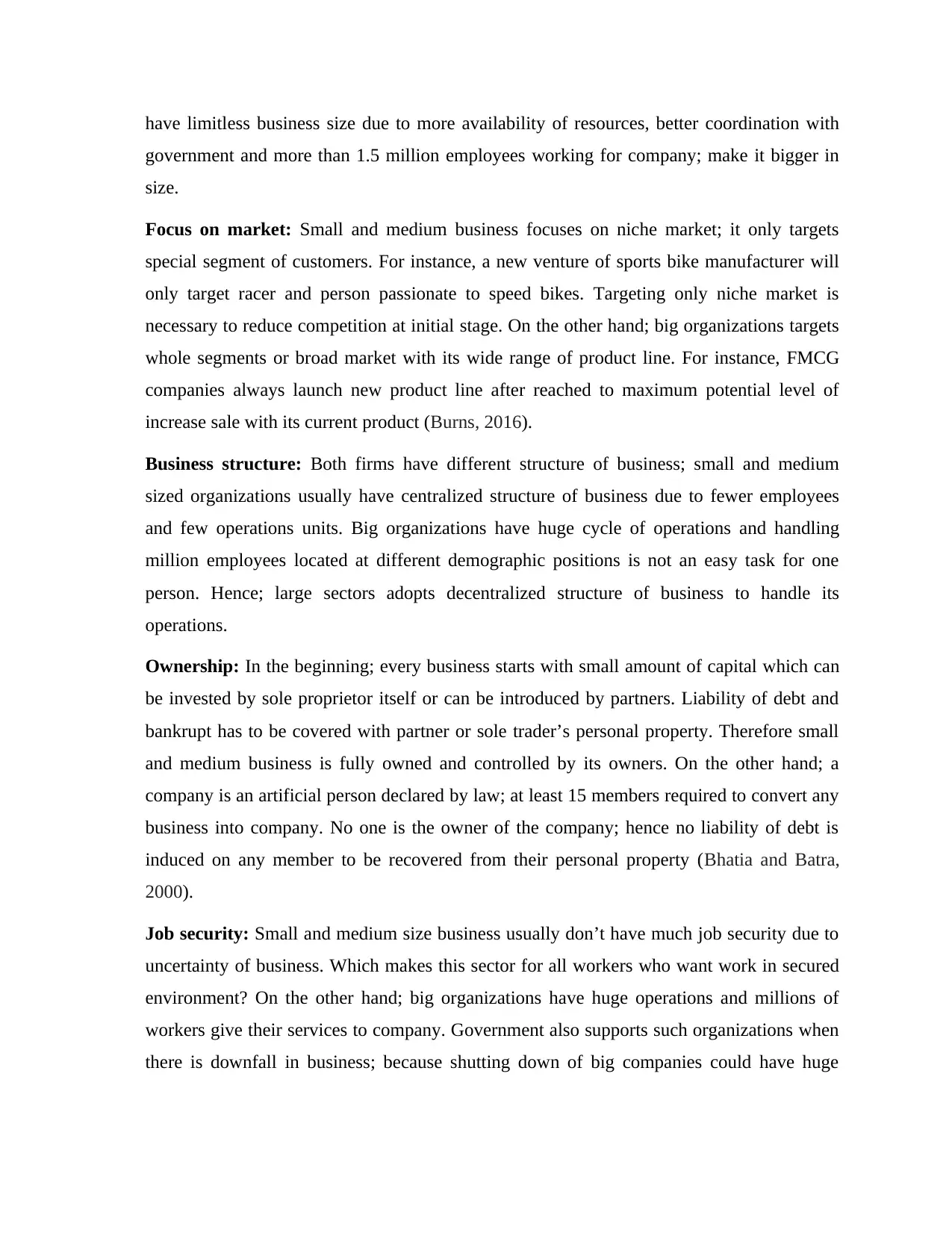
have limitless business size due to more availability of resources, better coordination with
government and more than 1.5 million employees working for company; make it bigger in
size.
Focus on market: Small and medium business focuses on niche market; it only targets
special segment of customers. For instance, a new venture of sports bike manufacturer will
only target racer and person passionate to speed bikes. Targeting only niche market is
necessary to reduce competition at initial stage. On the other hand; big organizations targets
whole segments or broad market with its wide range of product line. For instance, FMCG
companies always launch new product line after reached to maximum potential level of
increase sale with its current product (Burns, 2016).
Business structure: Both firms have different structure of business; small and medium
sized organizations usually have centralized structure of business due to fewer employees
and few operations units. Big organizations have huge cycle of operations and handling
million employees located at different demographic positions is not an easy task for one
person. Hence; large sectors adopts decentralized structure of business to handle its
operations.
Ownership: In the beginning; every business starts with small amount of capital which can
be invested by sole proprietor itself or can be introduced by partners. Liability of debt and
bankrupt has to be covered with partner or sole trader’s personal property. Therefore small
and medium business is fully owned and controlled by its owners. On the other hand; a
company is an artificial person declared by law; at least 15 members required to convert any
business into company. No one is the owner of the company; hence no liability of debt is
induced on any member to be recovered from their personal property (Bhatia and Batra,
2000).
Job security: Small and medium size business usually don’t have much job security due to
uncertainty of business. Which makes this sector for all workers who want work in secured
environment? On the other hand; big organizations have huge operations and millions of
workers give their services to company. Government also supports such organizations when
there is downfall in business; because shutting down of big companies could have huge
government and more than 1.5 million employees working for company; make it bigger in
size.
Focus on market: Small and medium business focuses on niche market; it only targets
special segment of customers. For instance, a new venture of sports bike manufacturer will
only target racer and person passionate to speed bikes. Targeting only niche market is
necessary to reduce competition at initial stage. On the other hand; big organizations targets
whole segments or broad market with its wide range of product line. For instance, FMCG
companies always launch new product line after reached to maximum potential level of
increase sale with its current product (Burns, 2016).
Business structure: Both firms have different structure of business; small and medium
sized organizations usually have centralized structure of business due to fewer employees
and few operations units. Big organizations have huge cycle of operations and handling
million employees located at different demographic positions is not an easy task for one
person. Hence; large sectors adopts decentralized structure of business to handle its
operations.
Ownership: In the beginning; every business starts with small amount of capital which can
be invested by sole proprietor itself or can be introduced by partners. Liability of debt and
bankrupt has to be covered with partner or sole trader’s personal property. Therefore small
and medium business is fully owned and controlled by its owners. On the other hand; a
company is an artificial person declared by law; at least 15 members required to convert any
business into company. No one is the owner of the company; hence no liability of debt is
induced on any member to be recovered from their personal property (Bhatia and Batra,
2000).
Job security: Small and medium size business usually don’t have much job security due to
uncertainty of business. Which makes this sector for all workers who want work in secured
environment? On the other hand; big organizations have huge operations and millions of
workers give their services to company. Government also supports such organizations when
there is downfall in business; because shutting down of big companies could have huge
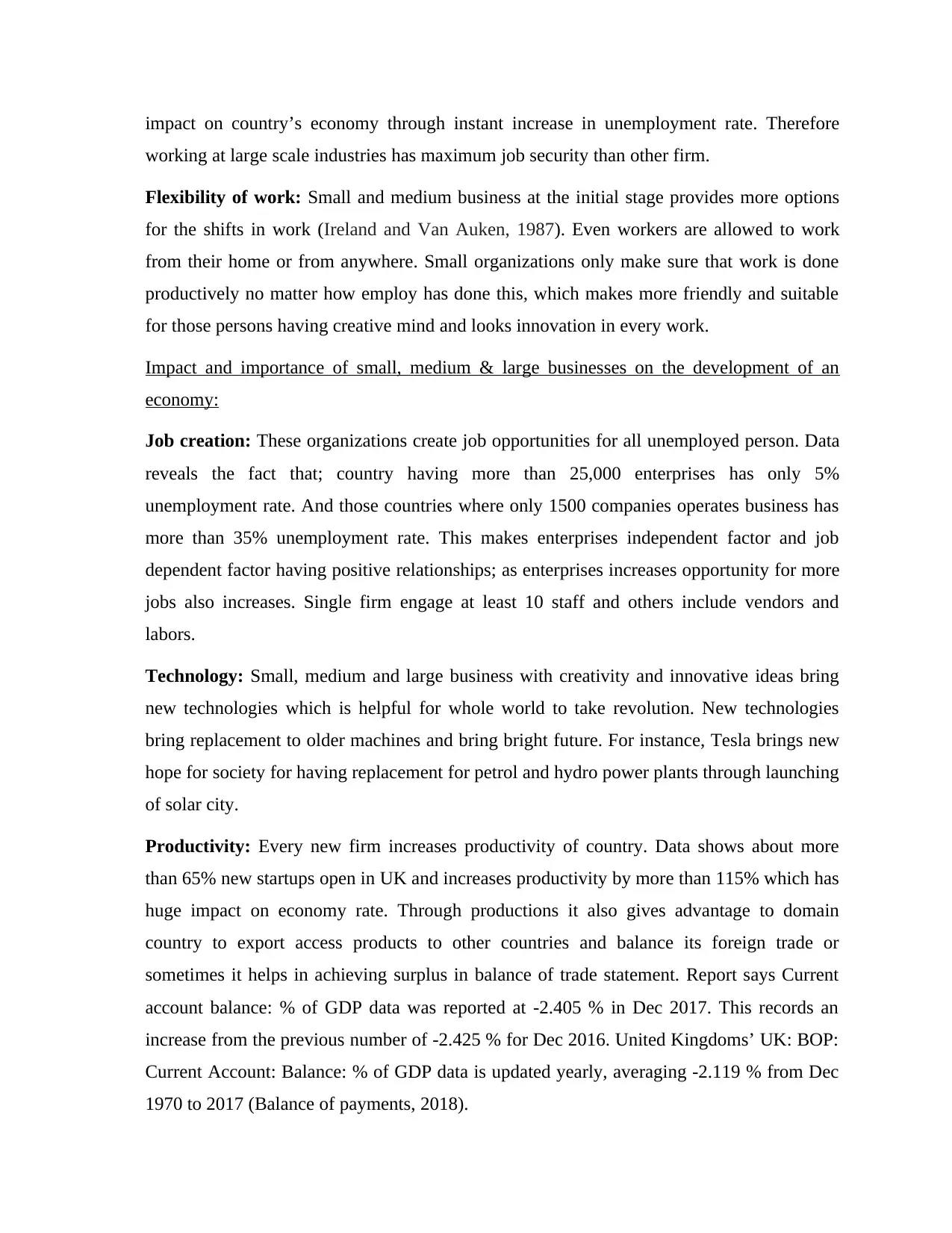
impact on country’s economy through instant increase in unemployment rate. Therefore
working at large scale industries has maximum job security than other firm.
Flexibility of work: Small and medium business at the initial stage provides more options
for the shifts in work (Ireland and Van Auken, 1987). Even workers are allowed to work
from their home or from anywhere. Small organizations only make sure that work is done
productively no matter how employ has done this, which makes more friendly and suitable
for those persons having creative mind and looks innovation in every work.
Impact and importance of small, medium & large businesses on the development of an
economy:
Job creation: These organizations create job opportunities for all unemployed person. Data
reveals the fact that; country having more than 25,000 enterprises has only 5%
unemployment rate. And those countries where only 1500 companies operates business has
more than 35% unemployment rate. This makes enterprises independent factor and job
dependent factor having positive relationships; as enterprises increases opportunity for more
jobs also increases. Single firm engage at least 10 staff and others include vendors and
labors.
Technology: Small, medium and large business with creativity and innovative ideas bring
new technologies which is helpful for whole world to take revolution. New technologies
bring replacement to older machines and bring bright future. For instance, Tesla brings new
hope for society for having replacement for petrol and hydro power plants through launching
of solar city.
Productivity: Every new firm increases productivity of country. Data shows about more
than 65% new startups open in UK and increases productivity by more than 115% which has
huge impact on economy rate. Through productions it also gives advantage to domain
country to export access products to other countries and balance its foreign trade or
sometimes it helps in achieving surplus in balance of trade statement. Report says Current
account balance: % of GDP data was reported at -2.405 % in Dec 2017. This records an
increase from the previous number of -2.425 % for Dec 2016. United Kingdoms’ UK: BOP:
Current Account: Balance: % of GDP data is updated yearly, averaging -2.119 % from Dec
1970 to 2017 (Balance of payments, 2018).
working at large scale industries has maximum job security than other firm.
Flexibility of work: Small and medium business at the initial stage provides more options
for the shifts in work (Ireland and Van Auken, 1987). Even workers are allowed to work
from their home or from anywhere. Small organizations only make sure that work is done
productively no matter how employ has done this, which makes more friendly and suitable
for those persons having creative mind and looks innovation in every work.
Impact and importance of small, medium & large businesses on the development of an
economy:
Job creation: These organizations create job opportunities for all unemployed person. Data
reveals the fact that; country having more than 25,000 enterprises has only 5%
unemployment rate. And those countries where only 1500 companies operates business has
more than 35% unemployment rate. This makes enterprises independent factor and job
dependent factor having positive relationships; as enterprises increases opportunity for more
jobs also increases. Single firm engage at least 10 staff and others include vendors and
labors.
Technology: Small, medium and large business with creativity and innovative ideas bring
new technologies which is helpful for whole world to take revolution. New technologies
bring replacement to older machines and bring bright future. For instance, Tesla brings new
hope for society for having replacement for petrol and hydro power plants through launching
of solar city.
Productivity: Every new firm increases productivity of country. Data shows about more
than 65% new startups open in UK and increases productivity by more than 115% which has
huge impact on economy rate. Through productions it also gives advantage to domain
country to export access products to other countries and balance its foreign trade or
sometimes it helps in achieving surplus in balance of trade statement. Report says Current
account balance: % of GDP data was reported at -2.405 % in Dec 2017. This records an
increase from the previous number of -2.425 % for Dec 2016. United Kingdoms’ UK: BOP:
Current Account: Balance: % of GDP data is updated yearly, averaging -2.119 % from Dec
1970 to 2017 (Balance of payments, 2018).
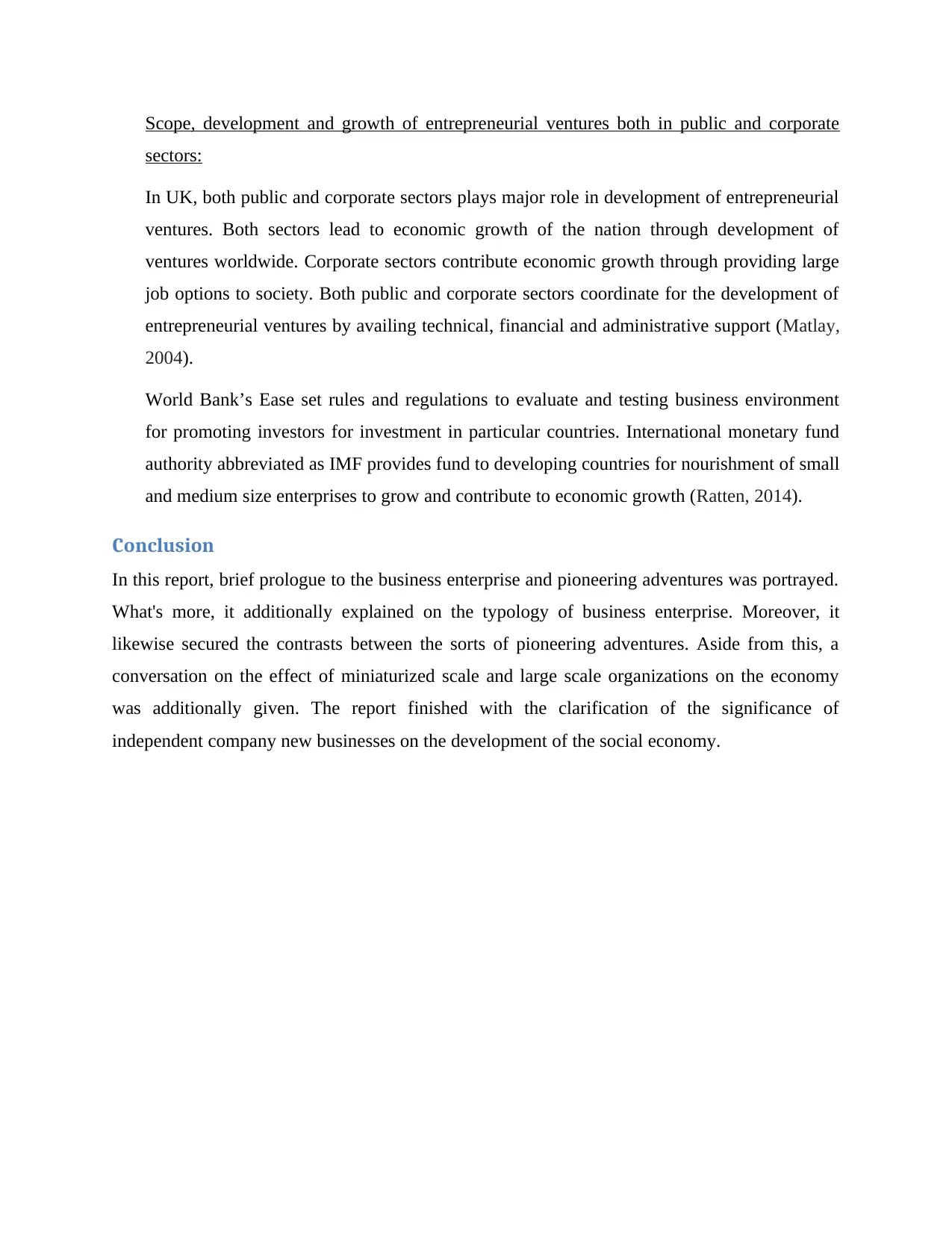
Scope, development and growth of entrepreneurial ventures both in public and corporate
sectors:
In UK, both public and corporate sectors plays major role in development of entrepreneurial
ventures. Both sectors lead to economic growth of the nation through development of
ventures worldwide. Corporate sectors contribute economic growth through providing large
job options to society. Both public and corporate sectors coordinate for the development of
entrepreneurial ventures by availing technical, financial and administrative support (Matlay,
2004).
World Bank’s Ease set rules and regulations to evaluate and testing business environment
for promoting investors for investment in particular countries. International monetary fund
authority abbreviated as IMF provides fund to developing countries for nourishment of small
and medium size enterprises to grow and contribute to economic growth (Ratten, 2014).
Conclusion
In this report, brief prologue to the business enterprise and pioneering adventures was portrayed.
What's more, it additionally explained on the typology of business enterprise. Moreover, it
likewise secured the contrasts between the sorts of pioneering adventures. Aside from this, a
conversation on the effect of miniaturized scale and large scale organizations on the economy
was additionally given. The report finished with the clarification of the significance of
independent company new businesses on the development of the social economy.
sectors:
In UK, both public and corporate sectors plays major role in development of entrepreneurial
ventures. Both sectors lead to economic growth of the nation through development of
ventures worldwide. Corporate sectors contribute economic growth through providing large
job options to society. Both public and corporate sectors coordinate for the development of
entrepreneurial ventures by availing technical, financial and administrative support (Matlay,
2004).
World Bank’s Ease set rules and regulations to evaluate and testing business environment
for promoting investors for investment in particular countries. International monetary fund
authority abbreviated as IMF provides fund to developing countries for nourishment of small
and medium size enterprises to grow and contribute to economic growth (Ratten, 2014).
Conclusion
In this report, brief prologue to the business enterprise and pioneering adventures was portrayed.
What's more, it additionally explained on the typology of business enterprise. Moreover, it
likewise secured the contrasts between the sorts of pioneering adventures. Aside from this, a
conversation on the effect of miniaturized scale and large scale organizations on the economy
was additionally given. The report finished with the clarification of the significance of
independent company new businesses on the development of the social economy.
Secure Best Marks with AI Grader
Need help grading? Try our AI Grader for instant feedback on your assignments.
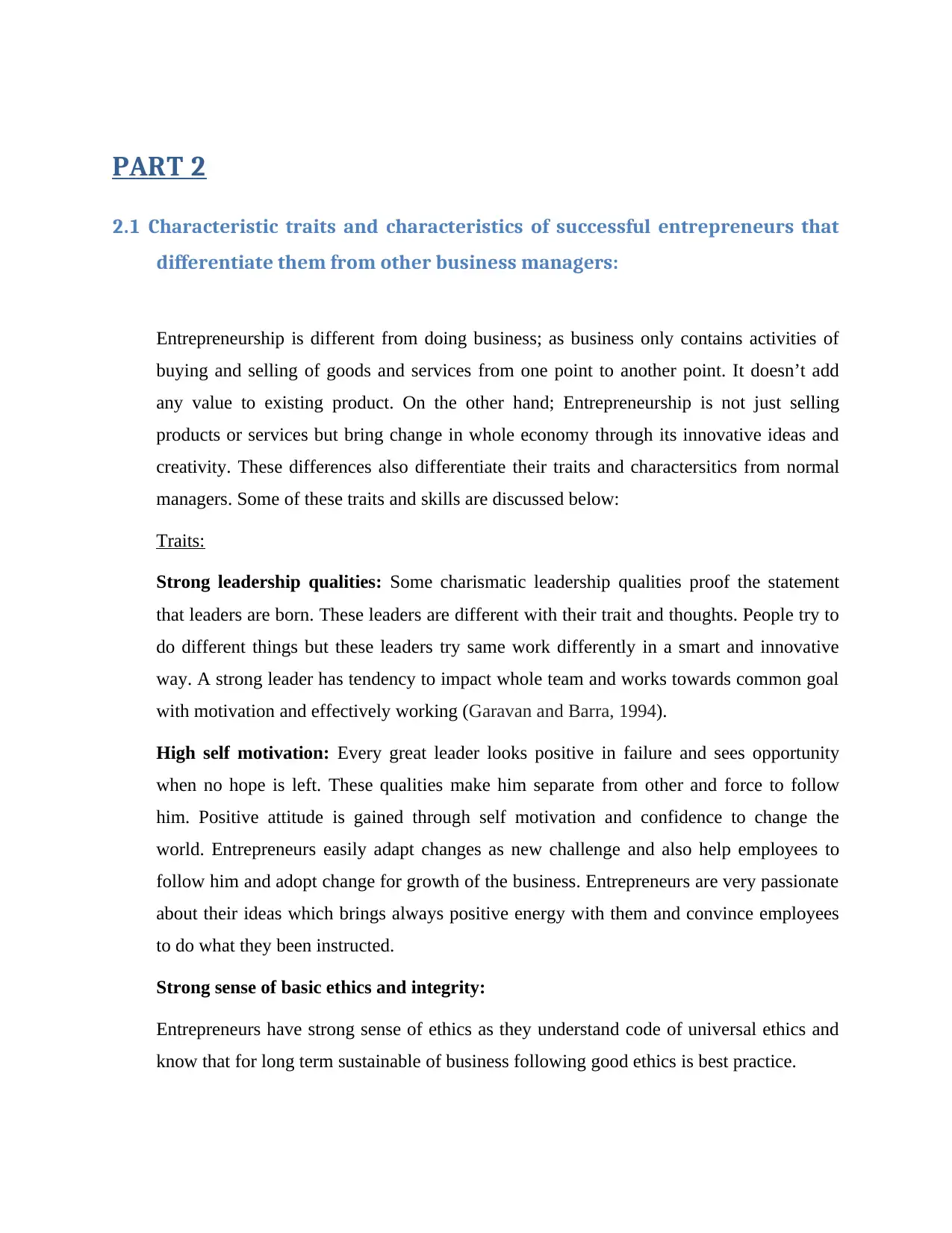
PART 2
2.1 Characteristic traits and characteristics of successful entrepreneurs that
differentiate them from other business managers:
Entrepreneurship is different from doing business; as business only contains activities of
buying and selling of goods and services from one point to another point. It doesn’t add
any value to existing product. On the other hand; Entrepreneurship is not just selling
products or services but bring change in whole economy through its innovative ideas and
creativity. These differences also differentiate their traits and charactersitics from normal
managers. Some of these traits and skills are discussed below:
Traits:
Strong leadership qualities: Some charismatic leadership qualities proof the statement
that leaders are born. These leaders are different with their trait and thoughts. People try to
do different things but these leaders try same work differently in a smart and innovative
way. A strong leader has tendency to impact whole team and works towards common goal
with motivation and effectively working (Garavan and Barra, 1994).
High self motivation: Every great leader looks positive in failure and sees opportunity
when no hope is left. These qualities make him separate from other and force to follow
him. Positive attitude is gained through self motivation and confidence to change the
world. Entrepreneurs easily adapt changes as new challenge and also help employees to
follow him and adopt change for growth of the business. Entrepreneurs are very passionate
about their ideas which brings always positive energy with them and convince employees
to do what they been instructed.
Strong sense of basic ethics and integrity:
Entrepreneurs have strong sense of ethics as they understand code of universal ethics and
know that for long term sustainable of business following good ethics is best practice.
2.1 Characteristic traits and characteristics of successful entrepreneurs that
differentiate them from other business managers:
Entrepreneurship is different from doing business; as business only contains activities of
buying and selling of goods and services from one point to another point. It doesn’t add
any value to existing product. On the other hand; Entrepreneurship is not just selling
products or services but bring change in whole economy through its innovative ideas and
creativity. These differences also differentiate their traits and charactersitics from normal
managers. Some of these traits and skills are discussed below:
Traits:
Strong leadership qualities: Some charismatic leadership qualities proof the statement
that leaders are born. These leaders are different with their trait and thoughts. People try to
do different things but these leaders try same work differently in a smart and innovative
way. A strong leader has tendency to impact whole team and works towards common goal
with motivation and effectively working (Garavan and Barra, 1994).
High self motivation: Every great leader looks positive in failure and sees opportunity
when no hope is left. These qualities make him separate from other and force to follow
him. Positive attitude is gained through self motivation and confidence to change the
world. Entrepreneurs easily adapt changes as new challenge and also help employees to
follow him and adopt change for growth of the business. Entrepreneurs are very passionate
about their ideas which brings always positive energy with them and convince employees
to do what they been instructed.
Strong sense of basic ethics and integrity:
Entrepreneurs have strong sense of ethics as they understand code of universal ethics and
know that for long term sustainable of business following good ethics is best practice.
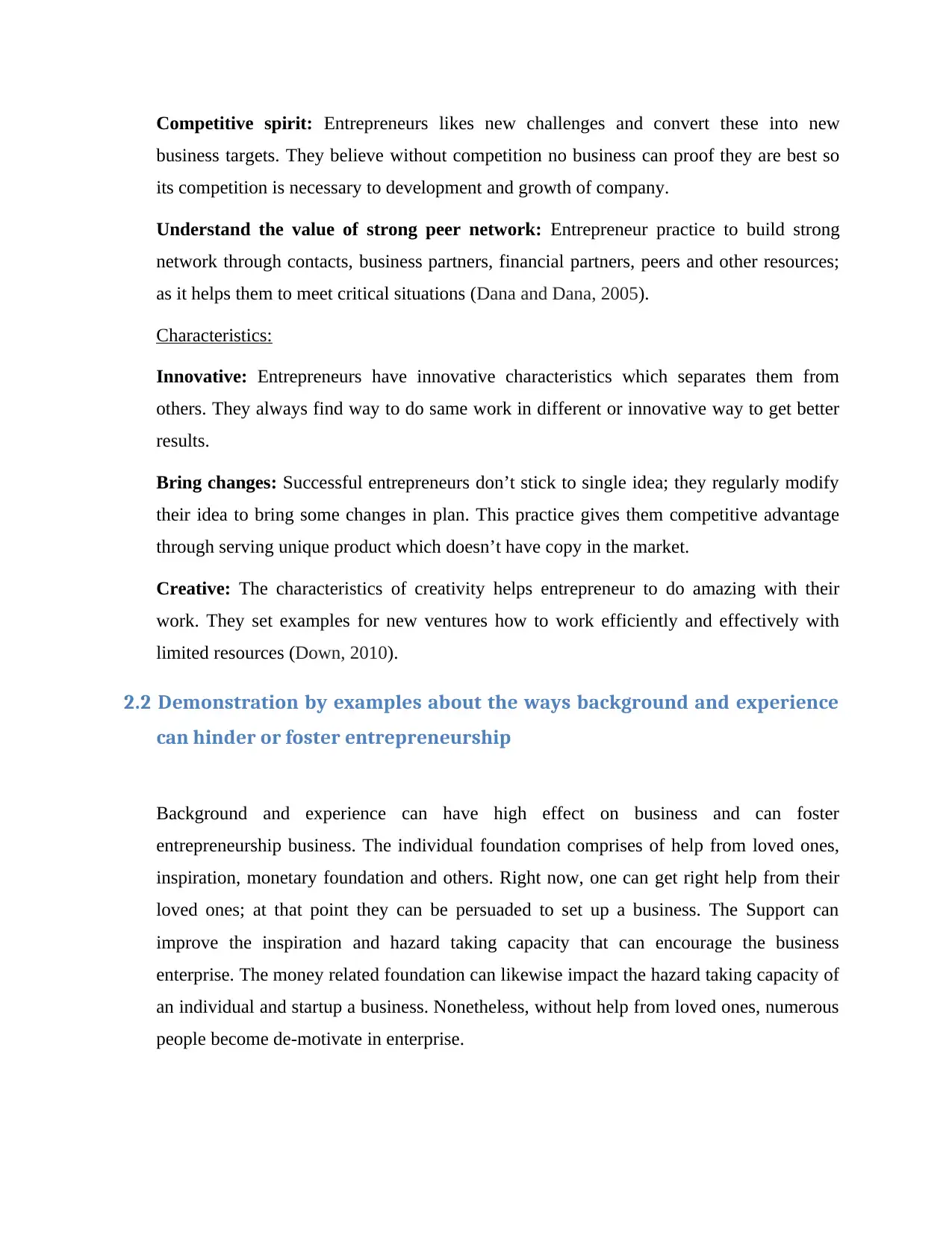
Competitive spirit: Entrepreneurs likes new challenges and convert these into new
business targets. They believe without competition no business can proof they are best so
its competition is necessary to development and growth of company.
Understand the value of strong peer network: Entrepreneur practice to build strong
network through contacts, business partners, financial partners, peers and other resources;
as it helps them to meet critical situations (Dana and Dana, 2005).
Characteristics:
Innovative: Entrepreneurs have innovative characteristics which separates them from
others. They always find way to do same work in different or innovative way to get better
results.
Bring changes: Successful entrepreneurs don’t stick to single idea; they regularly modify
their idea to bring some changes in plan. This practice gives them competitive advantage
through serving unique product which doesn’t have copy in the market.
Creative: The characteristics of creativity helps entrepreneur to do amazing with their
work. They set examples for new ventures how to work efficiently and effectively with
limited resources (Down, 2010).
2.2 Demonstration by examples about the ways background and experience
can hinder or foster entrepreneurship
Background and experience can have high effect on business and can foster
entrepreneurship business. The individual foundation comprises of help from loved ones,
inspiration, monetary foundation and others. Right now, one can get right help from their
loved ones; at that point they can be persuaded to set up a business. The Support can
improve the inspiration and hazard taking capacity that can encourage the business
enterprise. The money related foundation can likewise impact the hazard taking capacity of
an individual and startup a business. Nonetheless, without help from loved ones, numerous
people become de-motivate in enterprise.
business targets. They believe without competition no business can proof they are best so
its competition is necessary to development and growth of company.
Understand the value of strong peer network: Entrepreneur practice to build strong
network through contacts, business partners, financial partners, peers and other resources;
as it helps them to meet critical situations (Dana and Dana, 2005).
Characteristics:
Innovative: Entrepreneurs have innovative characteristics which separates them from
others. They always find way to do same work in different or innovative way to get better
results.
Bring changes: Successful entrepreneurs don’t stick to single idea; they regularly modify
their idea to bring some changes in plan. This practice gives them competitive advantage
through serving unique product which doesn’t have copy in the market.
Creative: The characteristics of creativity helps entrepreneur to do amazing with their
work. They set examples for new ventures how to work efficiently and effectively with
limited resources (Down, 2010).
2.2 Demonstration by examples about the ways background and experience
can hinder or foster entrepreneurship
Background and experience can have high effect on business and can foster
entrepreneurship business. The individual foundation comprises of help from loved ones,
inspiration, monetary foundation and others. Right now, one can get right help from their
loved ones; at that point they can be persuaded to set up a business. The Support can
improve the inspiration and hazard taking capacity that can encourage the business
enterprise. The money related foundation can likewise impact the hazard taking capacity of
an individual and startup a business. Nonetheless, without help from loved ones, numerous
people become de-motivate in enterprise.
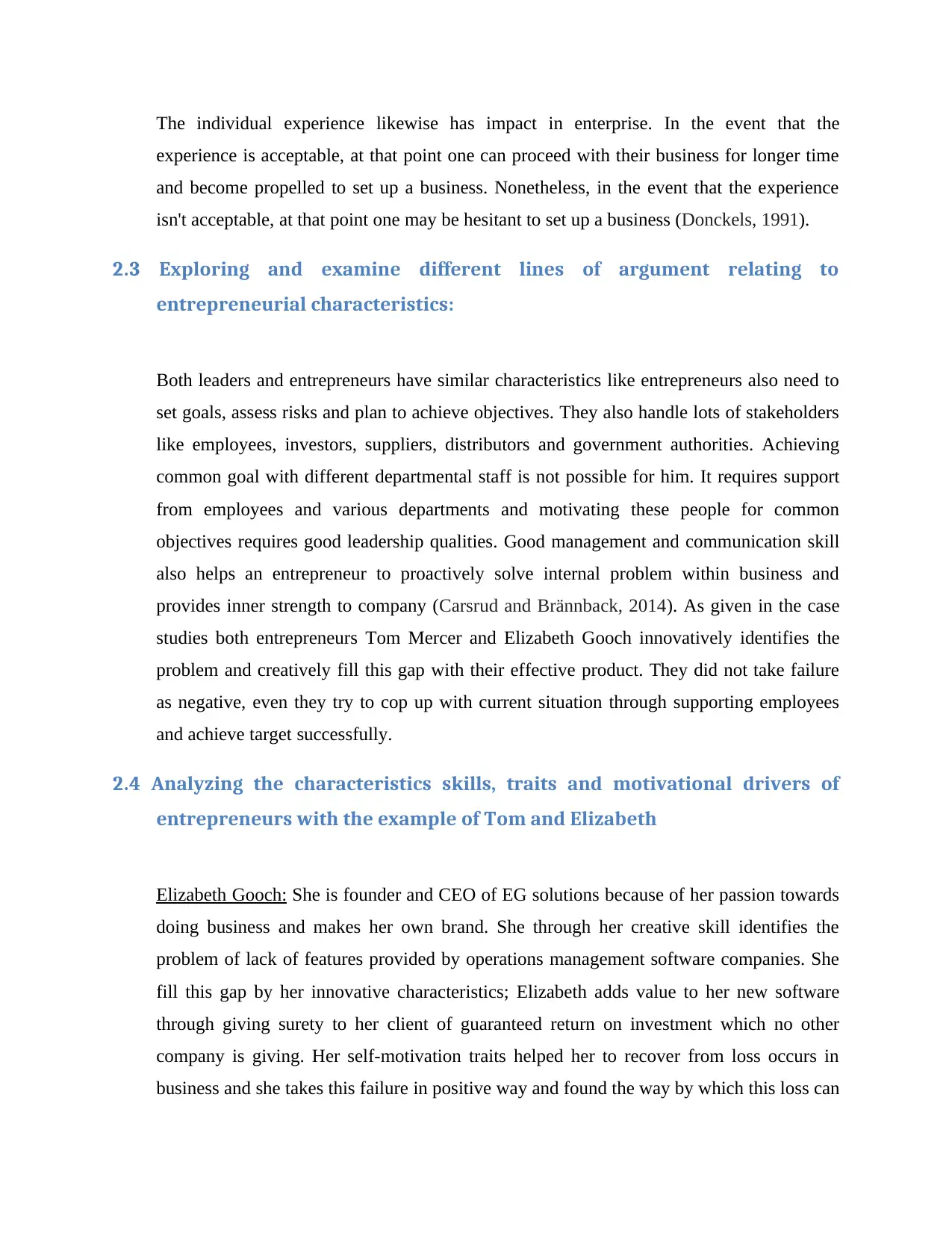
The individual experience likewise has impact in enterprise. In the event that the
experience is acceptable, at that point one can proceed with their business for longer time
and become propelled to set up a business. Nonetheless, in the event that the experience
isn't acceptable, at that point one may be hesitant to set up a business (Donckels, 1991).
2.3 Exploring and examine different lines of argument relating to
entrepreneurial characteristics:
Both leaders and entrepreneurs have similar characteristics like entrepreneurs also need to
set goals, assess risks and plan to achieve objectives. They also handle lots of stakeholders
like employees, investors, suppliers, distributors and government authorities. Achieving
common goal with different departmental staff is not possible for him. It requires support
from employees and various departments and motivating these people for common
objectives requires good leadership qualities. Good management and communication skill
also helps an entrepreneur to proactively solve internal problem within business and
provides inner strength to company (Carsrud and Brännback, 2014). As given in the case
studies both entrepreneurs Tom Mercer and Elizabeth Gooch innovatively identifies the
problem and creatively fill this gap with their effective product. They did not take failure
as negative, even they try to cop up with current situation through supporting employees
and achieve target successfully.
2.4 Analyzing the characteristics skills, traits and motivational drivers of
entrepreneurs with the example of Tom and Elizabeth
Elizabeth Gooch: She is founder and CEO of EG solutions because of her passion towards
doing business and makes her own brand. She through her creative skill identifies the
problem of lack of features provided by operations management software companies. She
fill this gap by her innovative characteristics; Elizabeth adds value to her new software
through giving surety to her client of guaranteed return on investment which no other
company is giving. Her self-motivation traits helped her to recover from loss occurs in
business and she takes this failure in positive way and found the way by which this loss can
experience is acceptable, at that point one can proceed with their business for longer time
and become propelled to set up a business. Nonetheless, in the event that the experience
isn't acceptable, at that point one may be hesitant to set up a business (Donckels, 1991).
2.3 Exploring and examine different lines of argument relating to
entrepreneurial characteristics:
Both leaders and entrepreneurs have similar characteristics like entrepreneurs also need to
set goals, assess risks and plan to achieve objectives. They also handle lots of stakeholders
like employees, investors, suppliers, distributors and government authorities. Achieving
common goal with different departmental staff is not possible for him. It requires support
from employees and various departments and motivating these people for common
objectives requires good leadership qualities. Good management and communication skill
also helps an entrepreneur to proactively solve internal problem within business and
provides inner strength to company (Carsrud and Brännback, 2014). As given in the case
studies both entrepreneurs Tom Mercer and Elizabeth Gooch innovatively identifies the
problem and creatively fill this gap with their effective product. They did not take failure
as negative, even they try to cop up with current situation through supporting employees
and achieve target successfully.
2.4 Analyzing the characteristics skills, traits and motivational drivers of
entrepreneurs with the example of Tom and Elizabeth
Elizabeth Gooch: She is founder and CEO of EG solutions because of her passion towards
doing business and makes her own brand. She through her creative skill identifies the
problem of lack of features provided by operations management software companies. She
fill this gap by her innovative characteristics; Elizabeth adds value to her new software
through giving surety to her client of guaranteed return on investment which no other
company is giving. Her self-motivation traits helped her to recover from loss occurs in
business and she takes this failure in positive way and found the way by which this loss can
Paraphrase This Document
Need a fresh take? Get an instant paraphrase of this document with our AI Paraphraser
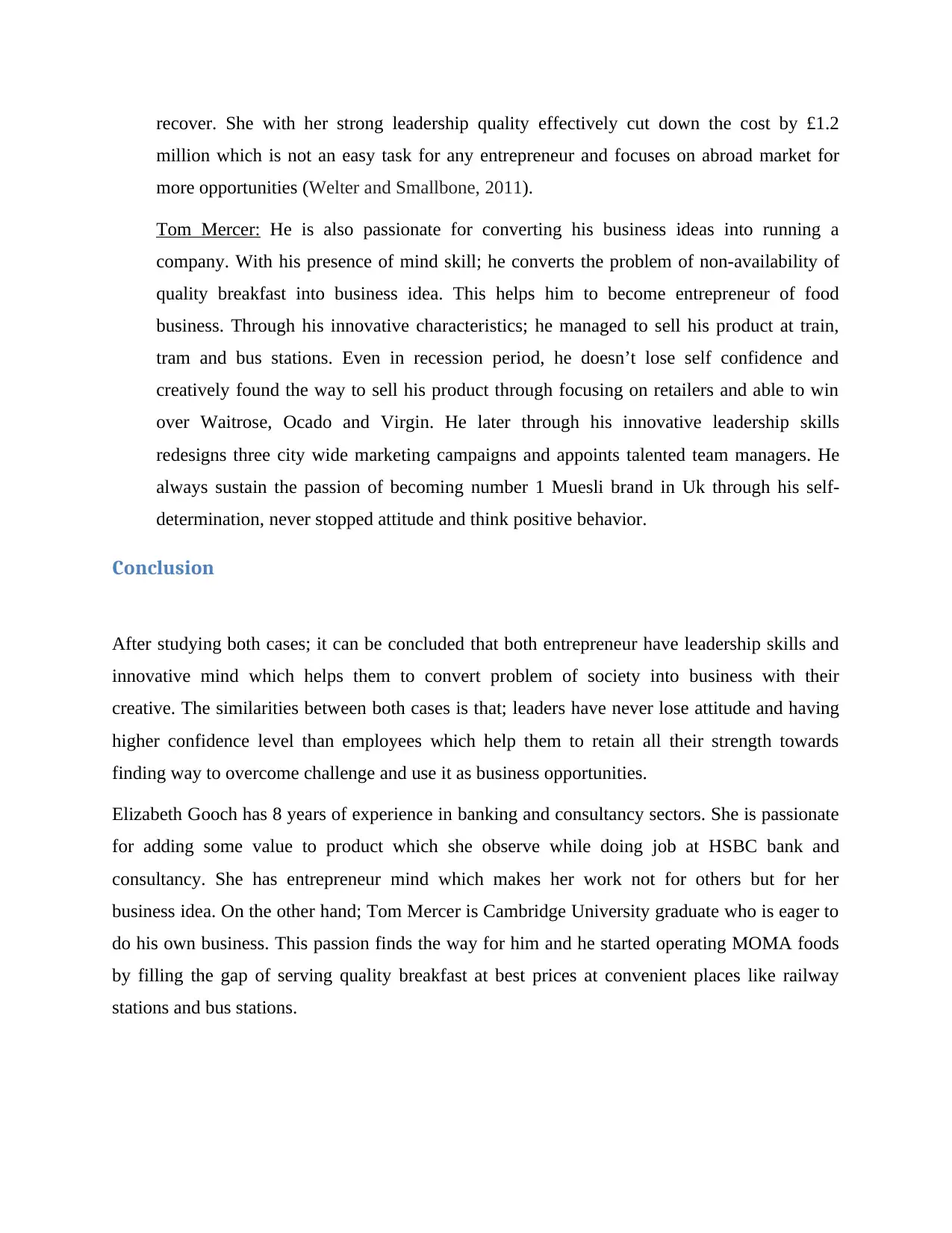
recover. She with her strong leadership quality effectively cut down the cost by £1.2
million which is not an easy task for any entrepreneur and focuses on abroad market for
more opportunities (Welter and Smallbone, 2011).
Tom Mercer: He is also passionate for converting his business ideas into running a
company. With his presence of mind skill; he converts the problem of non-availability of
quality breakfast into business idea. This helps him to become entrepreneur of food
business. Through his innovative characteristics; he managed to sell his product at train,
tram and bus stations. Even in recession period, he doesn’t lose self confidence and
creatively found the way to sell his product through focusing on retailers and able to win
over Waitrose, Ocado and Virgin. He later through his innovative leadership skills
redesigns three city wide marketing campaigns and appoints talented team managers. He
always sustain the passion of becoming number 1 Muesli brand in Uk through his self-
determination, never stopped attitude and think positive behavior.
Conclusion
After studying both cases; it can be concluded that both entrepreneur have leadership skills and
innovative mind which helps them to convert problem of society into business with their
creative. The similarities between both cases is that; leaders have never lose attitude and having
higher confidence level than employees which help them to retain all their strength towards
finding way to overcome challenge and use it as business opportunities.
Elizabeth Gooch has 8 years of experience in banking and consultancy sectors. She is passionate
for adding some value to product which she observe while doing job at HSBC bank and
consultancy. She has entrepreneur mind which makes her work not for others but for her
business idea. On the other hand; Tom Mercer is Cambridge University graduate who is eager to
do his own business. This passion finds the way for him and he started operating MOMA foods
by filling the gap of serving quality breakfast at best prices at convenient places like railway
stations and bus stations.
million which is not an easy task for any entrepreneur and focuses on abroad market for
more opportunities (Welter and Smallbone, 2011).
Tom Mercer: He is also passionate for converting his business ideas into running a
company. With his presence of mind skill; he converts the problem of non-availability of
quality breakfast into business idea. This helps him to become entrepreneur of food
business. Through his innovative characteristics; he managed to sell his product at train,
tram and bus stations. Even in recession period, he doesn’t lose self confidence and
creatively found the way to sell his product through focusing on retailers and able to win
over Waitrose, Ocado and Virgin. He later through his innovative leadership skills
redesigns three city wide marketing campaigns and appoints talented team managers. He
always sustain the passion of becoming number 1 Muesli brand in Uk through his self-
determination, never stopped attitude and think positive behavior.
Conclusion
After studying both cases; it can be concluded that both entrepreneur have leadership skills and
innovative mind which helps them to convert problem of society into business with their
creative. The similarities between both cases is that; leaders have never lose attitude and having
higher confidence level than employees which help them to retain all their strength towards
finding way to overcome challenge and use it as business opportunities.
Elizabeth Gooch has 8 years of experience in banking and consultancy sectors. She is passionate
for adding some value to product which she observe while doing job at HSBC bank and
consultancy. She has entrepreneur mind which makes her work not for others but for her
business idea. On the other hand; Tom Mercer is Cambridge University graduate who is eager to
do his own business. This passion finds the way for him and he started operating MOMA foods
by filling the gap of serving quality breakfast at best prices at convenient places like railway
stations and bus stations.
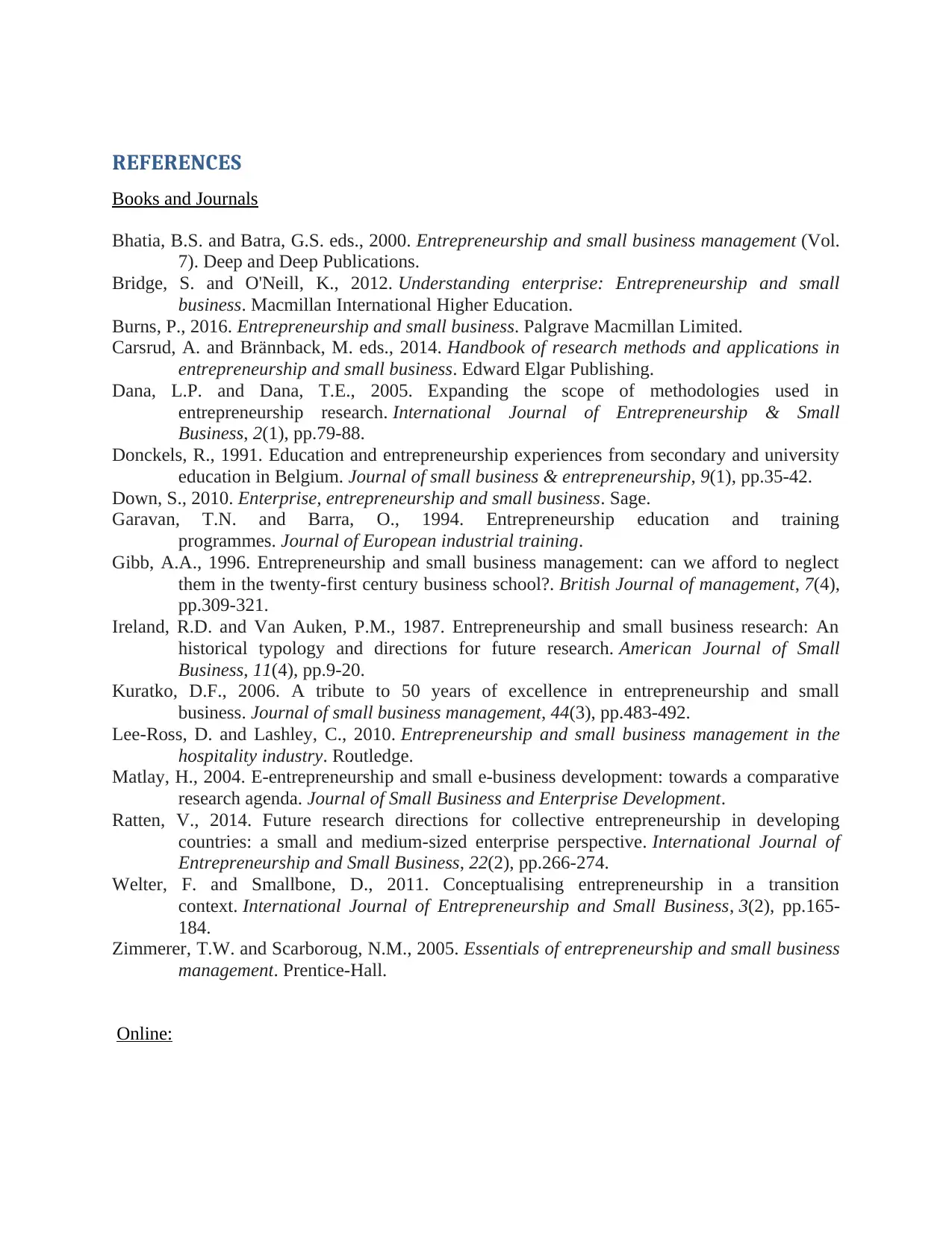
REFERENCES
Books and Journals
Bhatia, B.S. and Batra, G.S. eds., 2000. Entrepreneurship and small business management (Vol.
7). Deep and Deep Publications.
Bridge, S. and O'Neill, K., 2012. Understanding enterprise: Entrepreneurship and small
business. Macmillan International Higher Education.
Burns, P., 2016. Entrepreneurship and small business. Palgrave Macmillan Limited.
Carsrud, A. and Brännback, M. eds., 2014. Handbook of research methods and applications in
entrepreneurship and small business. Edward Elgar Publishing.
Dana, L.P. and Dana, T.E., 2005. Expanding the scope of methodologies used in
entrepreneurship research. International Journal of Entrepreneurship & Small
Business, 2(1), pp.79-88.
Donckels, R., 1991. Education and entrepreneurship experiences from secondary and university
education in Belgium. Journal of small business & entrepreneurship, 9(1), pp.35-42.
Down, S., 2010. Enterprise, entrepreneurship and small business. Sage.
Garavan, T.N. and Barra, O., 1994. Entrepreneurship education and training
programmes. Journal of European industrial training.
Gibb, A.A., 1996. Entrepreneurship and small business management: can we afford to neglect
them in the twenty‐first century business school?. British Journal of management, 7(4),
pp.309-321.
Ireland, R.D. and Van Auken, P.M., 1987. Entrepreneurship and small business research: An
historical typology and directions for future research. American Journal of Small
Business, 11(4), pp.9-20.
Kuratko, D.F., 2006. A tribute to 50 years of excellence in entrepreneurship and small
business. Journal of small business management, 44(3), pp.483-492.
Lee-Ross, D. and Lashley, C., 2010. Entrepreneurship and small business management in the
hospitality industry. Routledge.
Matlay, H., 2004. E‐entrepreneurship and small e‐business development: towards a comparative
research agenda. Journal of Small Business and Enterprise Development.
Ratten, V., 2014. Future research directions for collective entrepreneurship in developing
countries: a small and medium-sized enterprise perspective. International Journal of
Entrepreneurship and Small Business, 22(2), pp.266-274.
Welter, F. and Smallbone, D., 2011. Conceptualising entrepreneurship in a transition
context. International Journal of Entrepreneurship and Small Business, 3(2), pp.165-
184.
Zimmerer, T.W. and Scarboroug, N.M., 2005. Essentials of entrepreneurship and small business
management. Prentice-Hall.
Online:
Books and Journals
Bhatia, B.S. and Batra, G.S. eds., 2000. Entrepreneurship and small business management (Vol.
7). Deep and Deep Publications.
Bridge, S. and O'Neill, K., 2012. Understanding enterprise: Entrepreneurship and small
business. Macmillan International Higher Education.
Burns, P., 2016. Entrepreneurship and small business. Palgrave Macmillan Limited.
Carsrud, A. and Brännback, M. eds., 2014. Handbook of research methods and applications in
entrepreneurship and small business. Edward Elgar Publishing.
Dana, L.P. and Dana, T.E., 2005. Expanding the scope of methodologies used in
entrepreneurship research. International Journal of Entrepreneurship & Small
Business, 2(1), pp.79-88.
Donckels, R., 1991. Education and entrepreneurship experiences from secondary and university
education in Belgium. Journal of small business & entrepreneurship, 9(1), pp.35-42.
Down, S., 2010. Enterprise, entrepreneurship and small business. Sage.
Garavan, T.N. and Barra, O., 1994. Entrepreneurship education and training
programmes. Journal of European industrial training.
Gibb, A.A., 1996. Entrepreneurship and small business management: can we afford to neglect
them in the twenty‐first century business school?. British Journal of management, 7(4),
pp.309-321.
Ireland, R.D. and Van Auken, P.M., 1987. Entrepreneurship and small business research: An
historical typology and directions for future research. American Journal of Small
Business, 11(4), pp.9-20.
Kuratko, D.F., 2006. A tribute to 50 years of excellence in entrepreneurship and small
business. Journal of small business management, 44(3), pp.483-492.
Lee-Ross, D. and Lashley, C., 2010. Entrepreneurship and small business management in the
hospitality industry. Routledge.
Matlay, H., 2004. E‐entrepreneurship and small e‐business development: towards a comparative
research agenda. Journal of Small Business and Enterprise Development.
Ratten, V., 2014. Future research directions for collective entrepreneurship in developing
countries: a small and medium-sized enterprise perspective. International Journal of
Entrepreneurship and Small Business, 22(2), pp.266-274.
Welter, F. and Smallbone, D., 2011. Conceptualising entrepreneurship in a transition
context. International Journal of Entrepreneurship and Small Business, 3(2), pp.165-
184.
Zimmerer, T.W. and Scarboroug, N.M., 2005. Essentials of entrepreneurship and small business
management. Prentice-Hall.
Online:

Balance of payments, 2018; Online Available Through:
<https://www.ons.gov.uk/economy/nationalaccounts/balanceofpayments/bulletins/
balanceofpayments/quarter1jantomar2018>
<https://www.ons.gov.uk/economy/nationalaccounts/balanceofpayments/bulletins/
balanceofpayments/quarter1jantomar2018>
1 out of 16
Related Documents
Your All-in-One AI-Powered Toolkit for Academic Success.
+13062052269
info@desklib.com
Available 24*7 on WhatsApp / Email
![[object Object]](/_next/static/media/star-bottom.7253800d.svg)
Unlock your academic potential
© 2024 | Zucol Services PVT LTD | All rights reserved.




